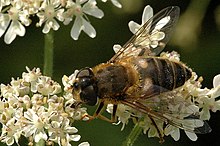Eristalis pertinax
| Eristalis pertinax | |
|---|---|

| |
| male | |

| |
| female | |
| Scientific classification | |
| Kingdom: | |
| Phylum: | |
| Class: | |
| Order: | |
| Family: | |
| Genus: | |
| Subgenus: | |
| Species: | E. pertinax
|
| Binomial name | |
| Eristalis pertinax (Scopoli, 1763)
| |
| Synonyms | |
Eristalis pertinax is a European hoverfly. Like Eristalis tenax, the larva of E. pertinax is a rat-tailed maggot and lives in drainage ditches, pools around manure piles, sewage, and similar places containing water with high organic load and low oxygen concentration.
Description[]
External images
For terms see Morphology of Diptera
Wing length 8.25–12.75 mm. Antennomere 3 brown-black. Arista plumose to tip. Tarsi 1 and 2 entirely yellow. Wing with diffusely bordered darkened median band and pterostigma 4 times as
long as wide. Dimorphic (males with triangular abdomen, females with squarish abdomen).[2][3][4][5]
The male genitalia are figured by Hippa et al. (2001).[6] The larva is figured by Hartley (1961).[7]
Distribution[]
Palaearctic Fennoscandia South to Iberia and the Mediterranean basin. Ireland East through Europe into Turkey and European Russia East to the Urals.[8][9]
Biology[]
The habitat is wetland, forest, alluvial forest, fen, farmland, suburban gardens and parks.[10] The flight period is February to November.
Gallery[]
Females of a European hoverfly ovipositing at a small pool in a forest near Marburg, Hesse, Germany
References[]
- ^ Stubbs, Alan E.; Falk, Steven J. (1983). British Hoverflies: An Illustrated Identification Guide. British Entomological & Natural History Society. pp. 253, xvpp.
- ^ Van Veen, M. (2004) Hoverflies of Northwest Europe: identification keys to the Syrphidae. 256pp. KNNV Publishing, Utrecht.addendum
- ^ Van der Goot,V.S. (1981) De zweefvliegen van Noordwest - Europa en Europees Rusland, in het bijzonder van de Benelux. Koninklijke Nederlandse Natuurhistorische Vereniging, Uitgave no.32: 275pp. Amsterdam.
- ^ Bei-Bienko, G.Y. & Steyskal, G.C. (1988) Keys to the Insects of the European Part of the USSR, Volume V: Diptera and Siphonaptera, Part I. Amerind Publishing Co., New Delhi. ISBN 81-205-0080-6.
- ^ Coe, R.L. (1953) Diptera: Syrphidae. Handbooks for Identification of British Insects, 10(1): 1–98. Royal Entomological Society of London. pdf
- ^ Hippa, H., Nielsen, T.R. & van Steenis, J. (2001) "The west Palaearctic species of the genus Eristalis Latreille (Diptera, Surphidae)". Norwegian Journal of Entomology, 48: 289–327.
- ^ Hartley, J.C. (1961) "A taxonomic account of the larvae of some British Syrphidae". Proceedings of the Zoological Society of London, 136: 505–573.
- ^ Fauna Europaea
- ^ Peck, L.V. (1988) "Syrphidae". In: Soos, A. & Papp, L. (eds.) Catalogue of Palaearctic Diptera, 8: 11–230. Akad.Kiado, Budapest.
- ^ Speight, M.C.D. (2011). "Species accounts of European Syrphidae (Diptera)" (PDF). Syrph the Net, the Database of European Syrphidae. 65: 285pp.
- Eristalinae
- Diptera of Europe
- Insects described in 1763
- Taxa named by Giovanni Antonio Scopoli
- Syrphidae stubs
